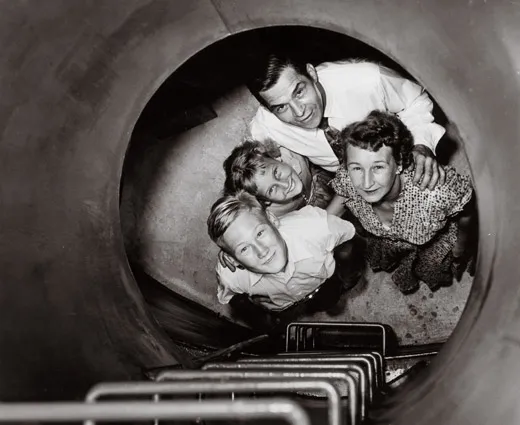The New Hot Item on the Housing Market: Bomb Shelters
The cold war may be over, but sales of a new breed of bomb shelter are on the rise. Prepare to survive Armageddon in style
/https://tf-cmsv2-smithsonianmag-media.s3.amazonaws.com/filer/FOB-bomb-shelter-631.jpg)
A decade of disasters, from 9/11 and Hurricane Katrina to widespread earthquakes, has ignited a boom in the bomb-shelter business. (So has the end of the world, which some claim the Maya pegged for this December.) New reality TV shows, including the Discovery Channel’s “Doomsday Bunkers,” track the phenomenon. And there’s an “exponential” growth in consumer interest, says California-based Robert Vicino, who aims to place 6,000 people in shelters built by his firm, Vivos. A share in his luxurious group bunkers, designed to house hundreds of inhabitants at each of several sites (an Indiana location is finished; a California project is underway) costs $10,000; the cash-strapped may pay less to lodge just their frozen gametes in an on-site “cryovault.” “If you won’t be around,” Vicino asserts cheerfully, “at least your bloodline will have a chance for survival.”
Various manufacturers of disaster shelters—including Hardened Structures in Virginia Beach, Virginia, and Radius Engineering in Terrell, Texas—offer bunkers designed to withstand a spectrum of potential catastrophes: comet strike, supervolcano, swine flu, solar flare, cyberterrorism, freak storm featuring 100-pound hailstones, brown dwarf star intrusion or global economic collapse. One may choose from specialized tsunami pods, tornado-proof mini-pyramids or more all-purpose luxury condos (complete with stainless steel appliances) nestled in former missile silos.
Speaking of those silos, the cold war-era suburban fallout shelter craze was equally surreal, says Susan Roy, author of Bomboozled: How the U.S. Government Misled Itself and Its People Into Believing They Could Survive a Nuclear Attack. Housewives planning to hunker down in backyard bunkers were advised to repurpose their ironing boards as stretchers and to plot post-Armageddon menus involving Bing cherries and creamed chipped beef.
Our deepest anxieties may underlie an impulse to build these shelters, says Stephen O’Leary, author of Arguing the Apocalypse. “It’s a magnification of our fear of death,” he says. In a secular age, O’Leary theorizes, those fears might take on greater resonance. “For those without the comfort of religion,” he adds, “to survive as long as possible is the best hope.”
